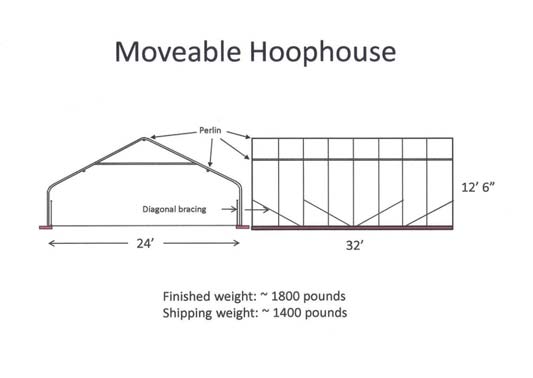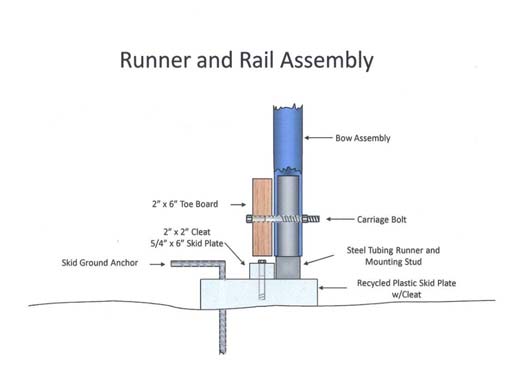Project Number: FW07-319
Title: Season Extension and Crop Area Multiplication with a Moveable Hoophouse in an Organic System
Ag Professional: Edward Page
Colorado State University
Area Extension Agent
1001 N. 2nd Street
Montrose, CO 81401
(970) 249-3935
edward.page@colostate.edu
Producer Advisor:
Mark Waltermire
Thistle Whistle Farm
10872 3500 Rd
Hotchkiss, CO 81419
(970) 872-4949
farmer_mark@surfglobal.net
Amount Funded: $11,230
Situation Western Colorado, like much of the Intermountain West, has a short growing season. At Thistle Whistle Farm near Hotchkiss, elevation 5,400 feet, the season is 140 days. The farm’s goal is to make a living producing food for the local population, but the short, variable seasons increase the risk.
 Extending the season and producing crops not grown in the area could reduce risk and increase income. Out-ofseason crops typically sell for more, and the labor to produce them is usually more readily available.
Extending the season and producing crops not grown in the area could reduce risk and increase income. Out-ofseason crops typically sell for more, and the labor to produce them is usually more readily available.
The added protection and improved environment afforded by permanent greenhouses can increase production and its value by as much as 110% or more. A moveable greenhouse that slides on
rails expands those benefits by allowing for protection of several crops as seasons progress.
Objectives
1. Explore the idea of expanding the ability of a hoophouse to extend the cropping season by building and testing a nonfixed hoophouse that slides on rails
2. Assess the performance of several new crops, and the expansion of existing crops, in cropping systems under the moveable hoophouse
3. Document the construction of the hoophouse system with detailed drawings, a bill of materials wi th current costs and step-by-step Power-Point and DVD depiction of construction techniques and share this and the results of the cropping systems with other producers
th current costs and step-by-step Power-Point and DVD depiction of construction techniques and share this and the results of the cropping systems with other producers
 Actions
Actions
The project team has divided the growing season into five cropping positions:
- winter: greens
- spring: asparagus
- early summer: tomatoes
- summer: heat-loving summer crops
- fall: raspberries
A control plot that mirrors the system under the moveable hoophouse is being planted to compare the cost and efficiencies of each system.
The hoophouse and rail system have been constructed and all the crops have been planted. The hoophouse is moved by two people pushing or pulling it with winches. Galvanized steel and lubricant were added to the rails to compensate for the slip-resistant oating of the original rail.
A DVD depicting the construction and planting is being made and will be available in fall 2008. The moveable hoophouse was featured March 22 in a “Season Extension & Moveable
Hoophouse Workshop” sponsored by Valley Organic Growers, Colorado State University Extension and Western SARE.
Results
Cost comparisons for the moveable hoophouse* versus a comparable permanent hoophouse:
Moveable Hoophouse
• Total cost of materials: $4,789.88
• Space covered: 3,840 square feet (768 square feet x five moves)
• Cost per square foot: $1.25 Permanent Hoophouse
• Total cost of materials: $3,270
• Space covered: 768 square feet
• Cost per square foot: $4.26
* The extra cost is for the rail system and added materials for mobility.
Potential Benefits
The project has the potential to extend the growing season to as many as 250 days, nearly double the current average of 140 days. Markets for the fruit and vegetables at new seasonal points will allow for greater production and profit. Current markets for organic produce from small growers in the North Fork Valley include farmers markets, restaurants, CSAs, off-farm sales, local
whole-food grocers and wholesale distribution to upscale mountain communities.
Expanding and extending the season should benefit growers serving these markets and offer the potential for expanded sales options, including:
- Sales to institutions including schools, hospitals and businesses with substantial numbers of employees (often called bag programs)
- Box deliveries to employees
- Cooperative marketing to institutions serving meals
Downloads:
- Poster: FW07_319.pdf 403.96 kB
- Handout: FW07_319_txt.pdf 305.89 kB
This article was originally published here: http://www.sare.org/Learning-Center/Conference-Materials/Western-SARE-Subregional-Materials/Southwest-Conference/Southwest-Posters-and-Handouts/Season-Extension-and-Crop-Multiplication-with-a-Moveable-Hoophouse-in-an-Organic-System




